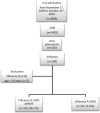Severe influenza A in a Tunisian ICU sentinel SARI centre: Epidemiological and clinical features
- PMID: 35793318
- PMCID: PMC9258871
- DOI: 10.1371/journal.pone.0270814
Severe influenza A in a Tunisian ICU sentinel SARI centre: Epidemiological and clinical features
Abstract
Introduction: Influenza A virus infection is a contagious acute respiratory infection which mostly evolves in an epidemic form, less frequently as pandemic outbreaks. It can take a severe clinical form that needs to be managed in intensive care unit (ICU). The aim of this study was to describe the epidemiological and clinical aspects of influenza A, then to determine independent predictive factors of ICU mortality in Abderrahmen Mami hospital, Ariana, Tunisia.
Methods: It was a single-center study, including all hospitalized patients in intensive care, between November 1st, 2009 and October 31st, 2019, with influenza A virus infection. We recorded demographic, clinical and biological data, evolving features; then multivariate analysis of the predictive factors of ICU mortality was realized.
Results: During the study period (10 consecutive seasons), 120 patients having severe Influenza A were admitted (Proportion = 2.5%) from all hospitalized patients, with a median age of 48 years and a gender-ratio of 1.14. Among women, 14 were pregnant. Only 7 patients (5.8%) have had seasonal flu vaccine during the year before ICU admission. The median values of the Simplified Acute Physiology Score II, Acute Physiologic and Chronic Health Evaluation II and Sepsis-related Organ Failure Assessment were respectively 26, 10 and 3. Virus strains identified with polymerase chain reaction were H1N1 pdm09 (84.2%) and H3N2 (15.8%). Antiviral therapy was prescribed in 88 (73.3%) patients. A co-infection was recorded in 19 cases: bacterial (n = 17) and aspergillaire (n = 2). An acute respiratory distress syndrome (ARDS) was diagnosed in 82 patients. Non-invasive ventilation (NIV) was conducted for 72 (60%) patients with success in 34 cases. Endotracheal intubation was performed in 59 patients with median duration of invasive mechanical ventilation 8 [3.25-13] days. The most frequent complications were acute kidney injury (n = 50, 41.7%), shock (n = 48, 40%), hospital-acquired infections (n = 46, 38.8%) and thromboembolic events (n = 19, 15.8%). The overall ICU mortality rate was of 31.7% (deceased n = 38). Independent predictive factors of ICU mortality identified were: age above 56 years (OR = 7.417; IC95% [1.474-37.317]; p = 0.015), PaO2/FiO2 ≤ 95 mmHg (OR = 9.078; IC95% [1.636-50.363]; p = 0.012) and lymphocytes count ≤ 1.325 109/L (OR = 10.199; IC95% [1.550-67.101]; p = 0.016).
Conclusion: Influenza A in ICU is not uncommon, even in A(H1N1) dominant seasons; its management is highly demanding. It is responsible for considerable morbi-mortality especially in elderly patients.
Conflict of interest statement
The authors have declared that no competing interests exist.
Figures
References
-
- Asia S. Up to 650 000 people die of respiratory diseases linked to seasonal flu each year. WHO 2017.
-
- Chlif S, Aissi W, Bettaieb J, Kharroubi G, Nouira M, Yazidi R, et al.. Modelling of seasonal influenza and estimation of the burden in Tunisia. EMHJ-Eastern Mediterranean Health Journal. 2016;22(7):459–66. - PubMed
MeSH terms
LinkOut - more resources
Full Text Sources
Medical




